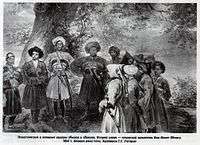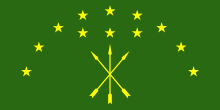Ubykh people
The Ubykh (Ubykh Circassian: пэху, туахы (tʷaχə), убых; Russian: убыхи; Turkish: Ubıhlar, Vubıhlar) are one of the twelve Circassian tribes, representing one of the twelve stars on the green-and-gold Circassian flag.[1] Along with the Natukhai and Shapsug tribes, the Ubykh were one of three coastal Circassian tribes to form the Circassian Assembly (Adyghe: Адыгэ Хасэ) in 1860.[2] Historically, they spoke a distinct Ubykh language,[3] which never existed in written form and went extinct in 1992 when Tevfik Esenç, the last speaker, died.
| Total population | |
|---|---|
| 20,000 | |
| Regions with significant populations | |
| Languages | |
| Ubykh language (historically), Turkish, Hakuchi Adyghe, Kabardian Adyghe | |
| Religion | |
| Sunni Islam | |
| Related ethnic groups | |
| Other Adyghe tribes, Abkhaz, Abaza |
History

The Ubykh used to inhabit the capital of Circassia, Sache (Circassian: Шъачэ, lit. seaside) — present-day Sochi, Krasnodar Krai, Russia . The province of the Ubykh tribe was situated between the Shapsug tribe near Tuapse and the Sadz (Dzhigets) in the north of Gagra.[4] The Ubykh tribe were mentioned in book IV of Procopius' De Bello Gothico (The Gothic War), under the name βροῦχοι (Bruchi), a corruption of the native term tʷaχ. In the 1667 book of Evliya Çelebi, the Ubykh were mentioned as Ubúr without any other information.[5]

The Ubykh were semi-nomadic horsemen, and had a finely-differentiated vocabulary related to horses and tack. Some Ubykh also practised favomancy and scapulimancy. However, the Ubykh gained more prominence in modern times. By 1864, during the reign of Tsar Alexander II, the Russian conquest of the Northwestern Caucasus had been completed. The other Circassian tribes and the Abkhaz were decimated, and the Abaza were partially driven out of the Caucasus.
Faced with the threat of subjugation by the Russian army, the Ubykh, as well as other Muslim peoples of Caucasus, left their homeland en masse beginning on 6 March 1864. By May 21, the entire Ubykh nation had departed from the Caucasus. They eventually settled in a number of villages in western Turkey around the municipality of Manyas.
In order to avoid discrimination, the Ubykh elders encouraged their people to assimilate into Turkish culture. Having abandoned their traditional nomadic culture, they became a nation of farmers. The Ubykh language was rapidly displaced by Turkish and other Circassian dialects; the last native speaker of Ubykh, Tevfik Esenç, died in 1992.
Today, the Ubykh diaspora has been scattered about Turkey and—to a much lesser extent—Jordan. The Ubykh nation per se no longer exists, although those who are of Ubykh ancestry are proud to call themselves Ubykh, and a couple of villages are still found in Turkey where the vast majority of the population is Ubykh by descent.
Ubykh society was patrilineal; many Ubykh descendants today know five, six, or even seven generations of their agnatic ancestry. Nevertheless, as in other Northwest Caucasian tribes, women were especially venerated, and the Ubykh retained a special second person pronoun prefix used exclusively with women (χa-).

Notable people
- Dina – Queen consort of Jordan (1955–1957)
- Keriman Halis Ece of Пщызэмыгъу family – winner of Miss Turkey 1932 and Miss Universe 1932 beauty pageants
- Perestü Valide Sultan of Гогэн family – Valide Sultan (Empress mother) of Abdulhamid II of the Ottoman Empire
- Şevkefza Valide Sultan of Заурмыкъу family – Valide Sultan (Empress mother) of Murad V of the Ottoman Empire
- Düzdidil Kadın - consort of Sultan Abdulmejid I of the Ottoman empire.
- Setenay Özbek - artist
- Tevfik Esenç - politician, last known speaker of the Ubykh language (1904-1992)
See also
- Ubykhia, a region in Circassia
- Other Circassian tribes:
References
- "Circassians". Adiga-home.net. 2010. Archived from the original on August 20, 2014. Retrieved 17 May 2016.
The 12 Circassian tribes: Abadzeh Besleney Bzhedug Yegeruqay Zhaney Kabarday Mamheg Natuhay Temirgoy Ubyh Shapsug Hatukay. The twelve stars on the Adyghe Flag also refers to the twelve tribes.
CS1 maint: unfit url (link) - United States Foreign Broadcast Information Service (1992). FBIS Report: Central Eurasia, Issues 91–96 (Report). The Service. p. 72. Retrieved 17 May 2016.
Yet this growth, in the opinion of the Shapsug themselves, is no more than an illusion, and it is quite likely that the fate of two other Adyg peoples — the Ubykh and the Natukhayevtsy, who have ceased to exist — will....
- Chirikba, Viacheslav Andreevich (1996). Common West Caucasian: the reconstruction of its phonological system and parts of its lexicon and morphology. Research School CNWS. p. 41.
Smeets 1988 adds to this list also Ubykh Circassian, i.e. the form of West Circassian as spoken by Ubykhs.
- Müller, Friedrich Max (1855). The Languages. London, UK: Williams and Norgate. p. 435.
The province of the Ubykh.
- Evliya Çelevi (1834). Joseph von Hammer-Purgstall (ed.). Narrative of travels in Europe, Asia, and Africa, in the seventeenth century. 2. p. 52.
External links
| Wikimedia Commons has media related to Ubykh people. |
- Journal of a residence in Circassia during the years 1837, 1838, and 1839 - Bell, James Stanislaus (English)
- Bagrat Shinkuba. The Last of the Departed on Circassian Library
